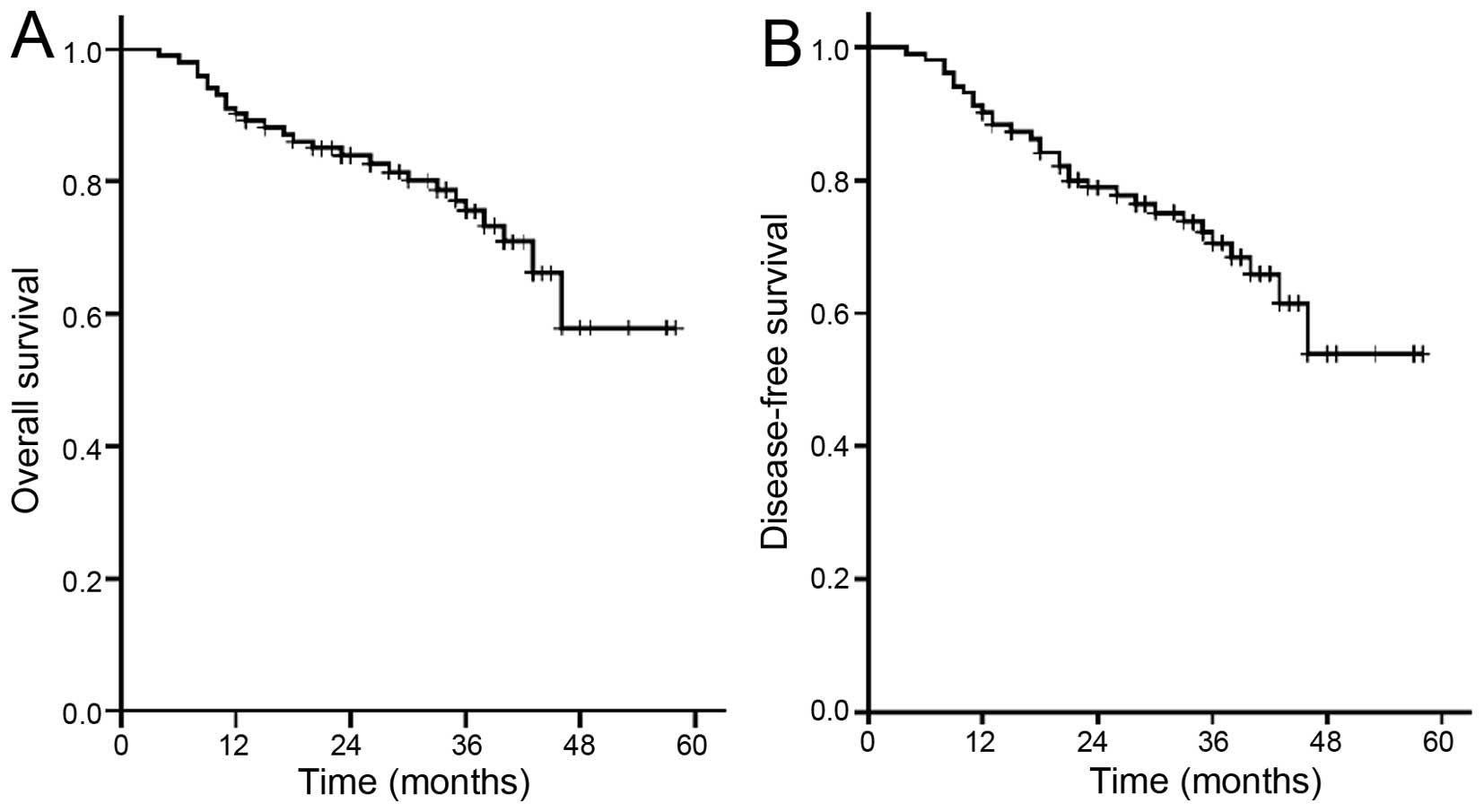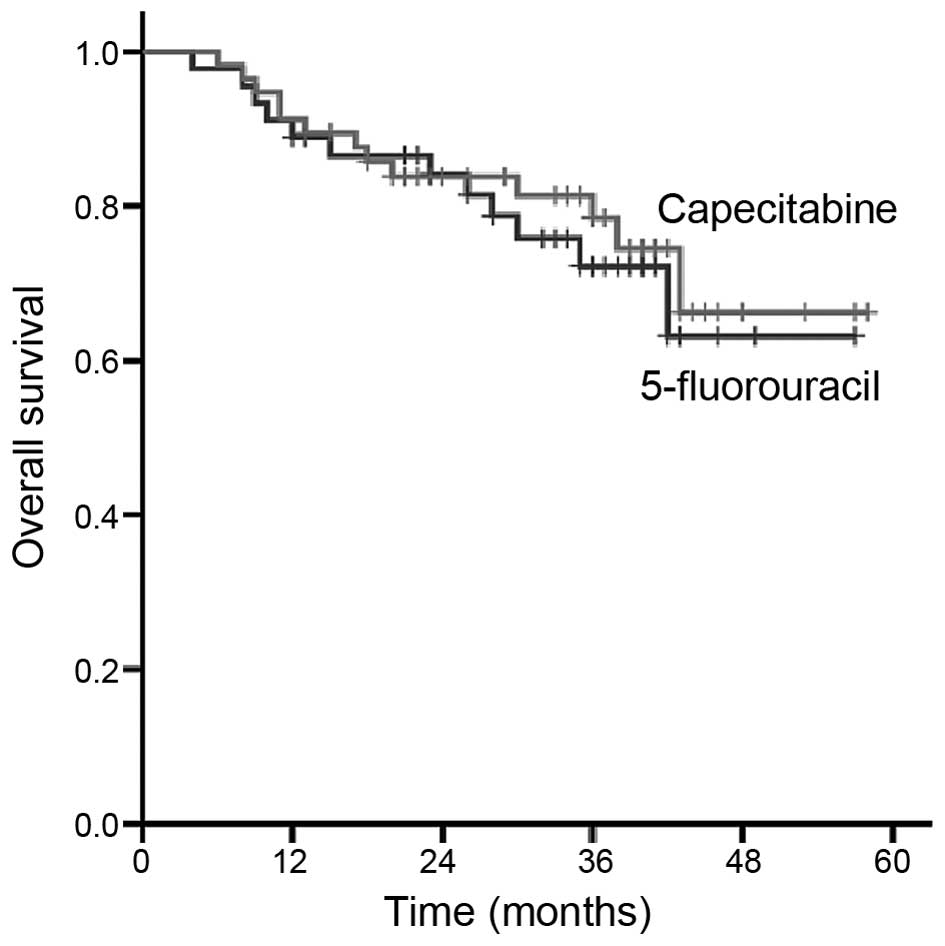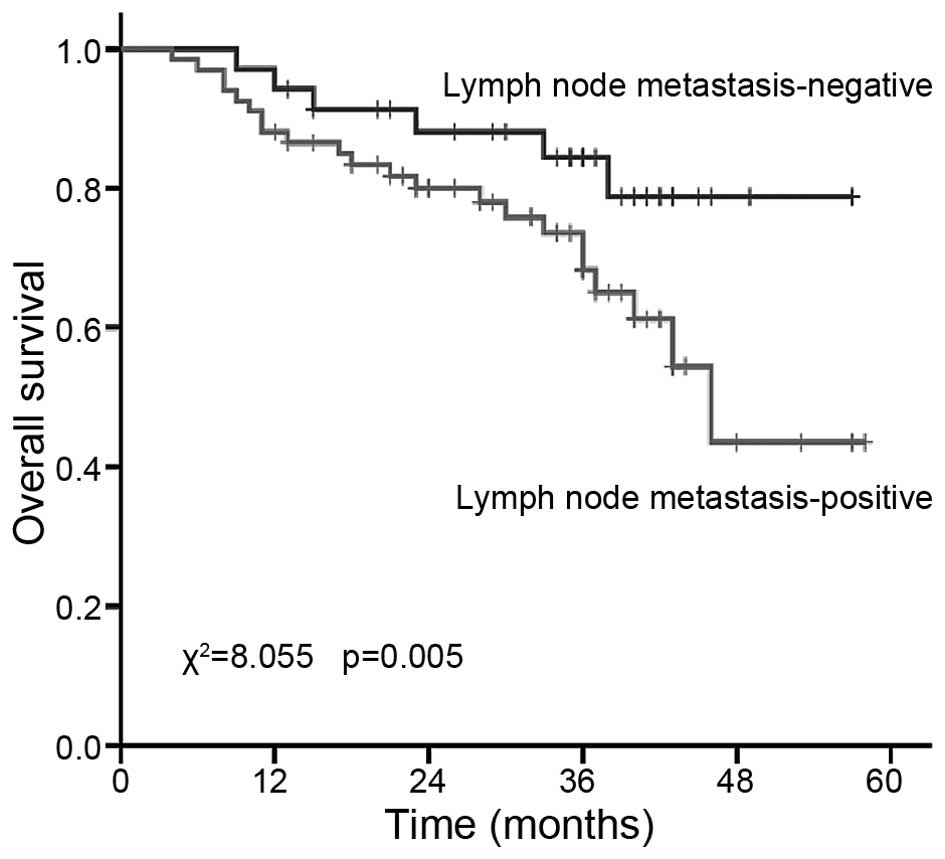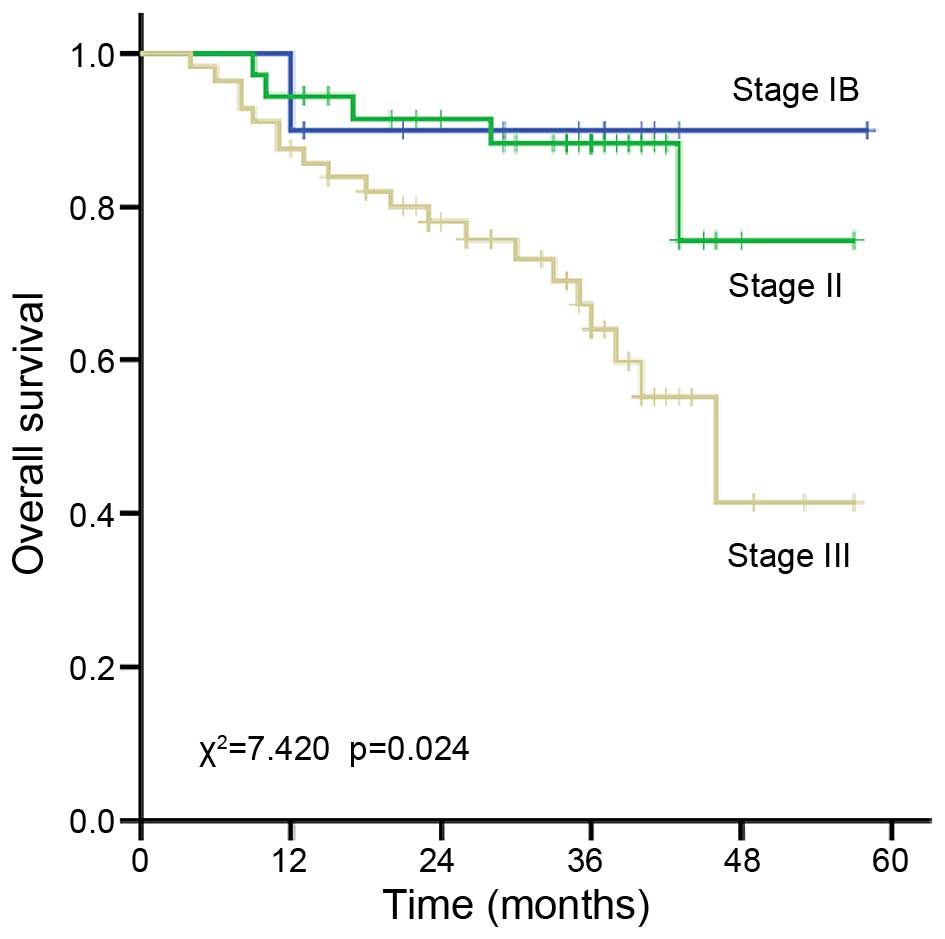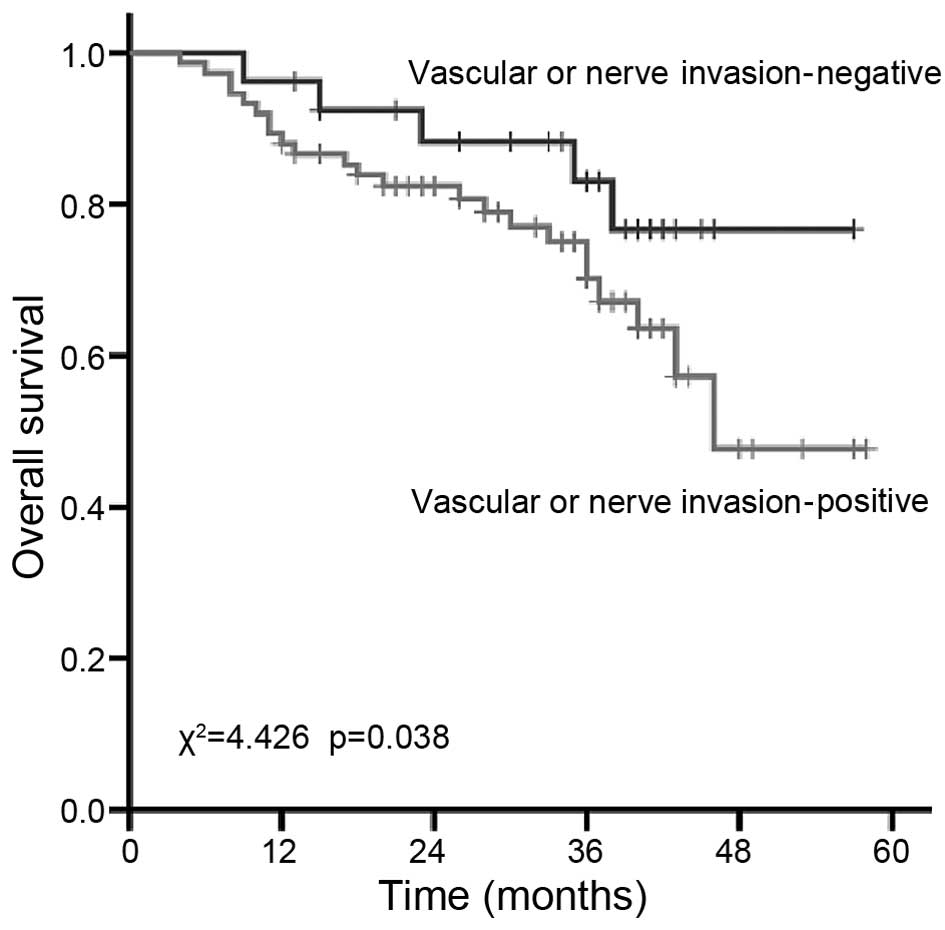|
1
|
Jemal A, Siegel R, Ward E, Hao Y, Xu J and
Thun MJ: Cancer statistics, 2009. CA Cancer J Clin. 59:225–249.
2009. View Article : Google Scholar : PubMed/NCBI
|
|
2
|
Parkin DM, Bray F, Ferlay J and Pisani P:
Global cancer statistics, 2002. CA Cancer J Clin. 55:74–108. 2005.
View Article : Google Scholar : PubMed/NCBI
|
|
3
|
Yoo CH, Noh SH, Shin DW, Choi SH and Min
JS: Recurrence following curative resection for gastric carcinoma.
Br J Surg. 87:236–242. 2000. View Article : Google Scholar : PubMed/NCBI
|
|
4
|
Landry J, Tepper JE, Wood WC, Moulton EO,
Koerner F and Sullinger J: Patterns of failure following curative
resection of gastric carcinoma. Int J Radiat Oncol Biol Phys.
19:1357–1362. 1990. View Article : Google Scholar : PubMed/NCBI
|
|
5
|
Lim DH, Kim DY, Kang MK, Kim YI, Kang WK,
Park CK, Kim S, Noh JH, Joh JW, Choi SH, et al: Patterns of failure
in gastric carcinoma after D2 gastrectomy and chemoradiotherapy: A
radiation oncologist's view. Br J Cancer. 91:11–17. 2004.
View Article : Google Scholar : PubMed/NCBI
|
|
6
|
Wisbeck WM, Becher EM and Russell AH:
Adenocarcinoma of the stomach: Autopsy observations with
therapeutic implications for the radiation oncologist. Radiother
Oncol. 7:13–18. 1986. View Article : Google Scholar : PubMed/NCBI
|
|
7
|
Gunderson LL: Gastric carcer-patterns of
relapse after surgical resection. Semin Radiat Oncol. 12:150–161.
2002. View Article : Google Scholar : PubMed/NCBI
|
|
8
|
Hundahl SA, Philips JL and Menck HR: The
National Cancer Data Base Report on poor survival of U.S. gastric
carcinoma patients treated with gastrectomy: Fifth edition American
Joint Committee on Cancer Staging, proximal disease and the
‘different disease’ hypothesis. Cancer. 88:921–932. 2000.
View Article : Google Scholar : PubMed/NCBI
|
|
9
|
Kulig J, Kolodziejczyk P, Sierzega M,
Bobrzynski L, Jedrys J, Popiela T, Dadan J, Drews M, Jeziorski A,
Krawczyk M, et al: Adjuvant chemotherapy with etoposide, adriamycin
and cisplatin compared with surgery alone in the treatment of
gastric cancer: A phase III randomized, multicenter, clinical
trial. Oncology. 78:54–61. 2010. View Article : Google Scholar : PubMed/NCBI
|
|
10
|
Di Costanzo F, Gasperoni S, Manzione L,
Bisagni G, Labianca R, Bravi S, Cortesi E, Carlini P, Bracci R,
Tomao S, et al: Adjuvant chemotherapy in completely resected
gastric cancer: A randomized phase III trial conducted by GOIRC. J
Natl Cancer Inst. 100:388–398. 2008. View Article : Google Scholar : PubMed/NCBI
|
|
11
|
Macdonald JS, Smalley SR, Benedetti J,
Hundahl SA, Estes NC, Stemmermann GN, Haller DG, Ajani JA,
Gunderson LL, Jessup JM and Martenson JA: Chemoradiotherapy after
surgery compared with surgery alone for adenocarcinoma of the
stomach or gastroesophageal junction. N Engl J Med. 345:725–730.
2001. View Article : Google Scholar : PubMed/NCBI
|
|
12
|
Kim S, Lim DH, Lee J, Kang WK, MacDonald
JS, Park CH, Park SH, Lee SH, Kim K, Park JO, et al: An
observational study suggesting clinical benefit for adjuvant
postoperative chemoradiation in a population of over 500 cases
after gastric resection with D2 nodal dissection for adenocarcinoma
of the stomach. Int J Radiat Oncol Biol Phys. 63:1279–1285. 2005.
View Article : Google Scholar : PubMed/NCBI
|
|
13
|
Lee J, Limdo H, Kim S, Park SH, Park JO,
Park YS, Lim HY, Choi MG, Sohn TS, Noh JH, et al: Phase III trial
comparing capecitabine plus cisplatin vs. capecitabine plus
cisplatin with concurrent capecitabine radiotherapy in completely
resected gastric cancer with D2 lymph node dissection: The ARTIST
trial. J Clin Oncol. 30:268–273. 2012. View Article : Google Scholar : PubMed/NCBI
|
|
14
|
Milano MT, Garofalo MC, Chmura SJ, Farrey
K, Rash C, Heimann R and Jani AB: Intensity-modulated radiation
therapy in the treatment of gastric cancer: Early clinical outcome
and dosimetric comparison with conventional techniques. Br J
Radiol. 79:497–503. 2006. View Article : Google Scholar : PubMed/NCBI
|
|
15
|
Ringash J, Perkins G, Brierley J, Lockwood
G, Islam M, Catton P, Cummings B, Kim J, Wong R and Dawson L: IMRT
for adjuvant radiation in gastric cancer: A preferred plan? Int J
Radiat Oncol Biol Phys. 63:732–738. 2005. View Article : Google Scholar : PubMed/NCBI
|
|
16
|
Sobin LH, Gospodarowicz MK and Wittekind
C: International Union Against Cancer (UICC) TNM Classification of
Malignant Tumours (7th). Wiley-Liss. New York: 73–76. 2010.
|
|
17
|
Smalley SR, Gunderson L, Tepper J,
Martenson JA Jr, Minsky B, Willett C and Rich T: Gastric surgical
adjuvant radiotherapy consensus report: Rationale and treatment
implementation. Int J Radiat Oncol Biol Phys. 52:283–293. 2002.
View Article : Google Scholar : PubMed/NCBI
|
|
18
|
Tepper JE and Gunderson LL: Radiation
treatment parameters in the adjuvant postoperative therapy of
gastric cancer. Semin Radiat Oncol. 12:187–195. 2002. View Article : Google Scholar : PubMed/NCBI
|
|
19
|
Trotti A, Colevas AD, Setser A, Rusch V,
Jaques D, Budach V, Langer C, Murphy B, Cumberlin R, Coleman CN and
Rubin P: CTCAE v3.0: Development of a comprehensive grading system
for the adverse effects of cancer treatment. Semin Radiat Oncol.
13:176–181. 2003. View Article : Google Scholar : PubMed/NCBI
|
|
20
|
Oblak I, Velenik V, Anderluh F and Strojan
P: Results of adjuvant radiochemotherapy for gastric adenocarcinoma
in Slovenia. EurJ Surg Oncol. 33:982–987. 2007. View Article : Google Scholar
|
|
21
|
Macdonald JS, Benedetti J, Smalley S, et
al: Chemoradiation of resected gastric cancer: A 10-year follow-up
of the phase III trial INT0116 (SWOG 9008). J Clin Oncol.
27:4515–4520. 2009.PubMed/NCBI
|
|
22
|
Boda-Heggemann J, Hofheinz RD, Weiss C,
Mennemeyer P, Mai SK, Hermes P, Wertz H, Post S, Massner B, Hieber
U, et al: Combined adjuvant radiochemotherapy with IMRT/XELOX
improves outcome with low renal toxicity in gastric cancer. Int J
Radiat Oncol Biol Phys. 75:1187–1195. 2009. View Article : Google Scholar : PubMed/NCBI
|
|
23
|
Minn AY, Hsu A, La T, Kunz P, Fisher GA,
Ford JM, Norton JA, Visser B, Goodman KA, Koong AC and Chang DT:
Comparison of intensity-modulated radiotherapy and 3-dimensional
conformal radiotherapy as adjuvant therapy for gastric cancer.
Cancer. 116:3943–3952. 2010. View Article : Google Scholar : PubMed/NCBI
|
|
24
|
Badakhshi H, Gruen A, Graf R, Boehmer D
and Budach V: Image-guided intensity-modulated radiotherapy for
patients with locally advanced gastric cancer: A clinical
feasibility study. Gastric Cancer. 17:537–541. 2014. View Article : Google Scholar : PubMed/NCBI
|
|
25
|
Vaishampayan UN, Ben-Josef E, Philip PA,
Vaitkevicius VK, Du W, Levin KJ and Shields AF: A
single-institution experience with concurrent capecitabine and
radiation therapy in gastrointestinal malignancies. Int J Radiat
Oncol Biol Phys. 53:675–679. 2002. View Article : Google Scholar : PubMed/NCBI
|
|
26
|
Osti MF, Agolli L, Bracci S, Monaco F,
Tubin S, Minniti G, De Sanctis V and Enrici RM: Adjuvant
chemoradiation with 5-fluorouracil or capecitabine in patients with
gastric cancer after D2 nodal dissection. Anticancer Res.
32:1397–1402. 2012.PubMed/NCBI
|
|
27
|
Hofheinz RD, Wenz F, Lukan N, Mai S, Kripp
M, Staiger W, Schwarzbach M, Willeke F, Möhler M, Post S and
Hochhaus A: Oxaliplatin and capecitabine-based chemoradiotherapy
for gastric cancer-an extended phase I MARGIT and AIO trial. Int J
Radiat Oncol Biol Phys. 73:142–147. 2012. View Article : Google Scholar
|
|
28
|
Bang YJ, Kim YW, Yang HK, Chung HC, Park
YK, Lee KH, Lee KW, Kim YH, Noh SI, Cho JY, et al: Adjuvant
capecitabine and oxaliplatin for gastric cancer after D2
gastrectomy (CLASSIC): A phase 3 open-label, randomised controlled
trial. Lancet. 379:315–321. 2012. View Article : Google Scholar : PubMed/NCBI
|
|
29
|
Kim DY, Seo KW, Joo JK, Park YK, Ryu SY,
Kim HR, Kim YJ and Kim SK: Prognostic factors in patients with
node-negative gastric carcinoma: A comparison with node-positive
gastric carcinoma. World J Gastroenterol. 12:1182–1186. 2006.
View Article : Google Scholar : PubMed/NCBI
|
|
30
|
Saito H, Kuroda H, Matsunaga T, Fukuda K,
Tatebe S, Tsujitani S and Ikeguchi M: Prognostic indicators in
node-negative advanced gastric cancer patients. J Surg Oncol.
101:622–625. 2010. View Article : Google Scholar : PubMed/NCBI
|
|
31
|
Lemmens VE, Dassen AE, van der Wurff AA,
Coebergh JW and Bosscha K: Lymph node examination among patients
with gastric cancer: Variation between departments of pathology and
prognostic impact of lymph node ratio. Eur J Surg Oncol.
37:488–496. 2011. View Article : Google Scholar : PubMed/NCBI
|
|
32
|
Kim CY and Yang DH: Adjustment of N stages
of gastric cancer by the ratio between the metastatic and examined
lymph nodes. Ann Surg Oncol. 16:1868–1874. 2009. View Article : Google Scholar : PubMed/NCBI
|
|
33
|
Deng J, Liang H, Sun D, Zhang R, Zhan H
and Wang X: Prognosis of gastric cancer patients with node-negative
metastasis following curative resection: Outcomes of the survival
and recurrence. Can J Gastroenterol. 22:835–839. 2008. View Article : Google Scholar : PubMed/NCBI
|
|
34
|
Baiocchi GL, Tiberio GA, Minicozzi AM,
Morgagni P, Marrelli D, Bruno L, Rosa F, Marchet A, Coniglio A,
Saragoni L, et al: A multicentric Western analysis of prognostic
factors in advanced, node-negative gastric cancer patients. Ann
Surg. 252:70–73. 2010. View Article : Google Scholar : PubMed/NCBI
|
|
35
|
Du C, Zhou Y, Huang K, Zhao G, Fu H and
Shi Y: Defining a high-risk subgroup of pathological T2N0 gastric
cancer by prognostic risk stratification for adjuvant therapy. J
Gastrointest Surg. 15:2153–2158. 2011. View Article : Google Scholar : PubMed/NCBI
|
|
36
|
Qiu MZ, Wang ZQ, Luo HY, Zhang DS, Zhou
ZW, Li YH, Jiang WQ and Xu RH: Prognostic analysis in node-negative
gastric cancer patients in China. Tumor Biol. 32:489–492. 2011.
View Article : Google Scholar
|















